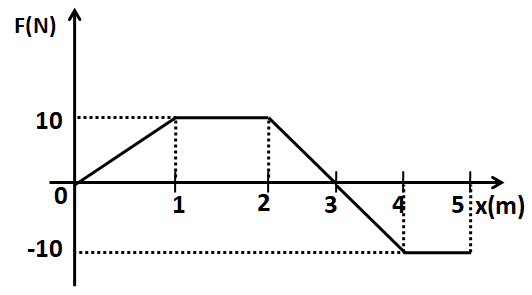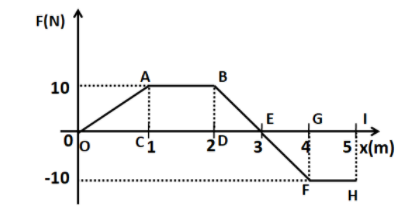
A position dependent force $F$ is acting on a particle and its force-position curve is shown in the figure. Work done on the particle, when its displacement is from $0$ to $5m$ is?

(A) \[35{\text{J}}\]
(B) $25{\text{J}}$
(C) \[15{\text{J}}\]
(D) $5{\text{J}}$
Answer
218.1k+ views
Hint: The work done on a particle by a force is equal to the area under the force-position curve for the particle. So we need to find the area under the curve in the given range of position of the particle.
Complete step-by-step solution:
We know that the work done by a force on a particle in displacing a particle is equal to the product of the force and the displacement. So it can be given by
$W = Fx$
But if the force is variable, then we consider the small work done by the force in displacing the particle through a small displacement $dx$ as below
$dW = Fdx$
For total work done, we integrate both sides to get
$\int_0^W {dW} = \int_{{x_1}}^{{x_2}} {Fdx} $
$ \Rightarrow W = \int_{{x_1}}^{{x_2}} {Fdx} $
So the work done is equal to the integration of the force with respect to the displacement. We know that the integration is geometrically interpreted as the area. So the work done is equal to the area under the force position curve given in the question. Now, we label the given curve as shown in the below figure

We can see that the curve consists of two trapeziums, OABE and EFHI. So the work done is given by
$W = \dfrac{{AC}}{2}\left( {AB + OE} \right) - \dfrac{{FG}}{2}\left( {FH + EI} \right)$
$ \Rightarrow W = \dfrac{{10}}{2}\left( {1 + 3} \right) - \dfrac{{10}}{2}\left( {1 + 2} \right)$
On solving we get
$W = 5{\text{J}}$
Thus, the work done is equal to $5{\text{J}}$.
Hence, the correct answer is option D.
Note: Make it sure to add the areas of the shapes of the curve algebraically, and not their absolute values. This is because for the curve which lies below the x-axis, the work done is negative. Also, we could make the solution easy by identifying similar shapes above and below the x-axis, so that their areas get cancelled and the area of the remaining shape would be the final answer.
Complete step-by-step solution:
We know that the work done by a force on a particle in displacing a particle is equal to the product of the force and the displacement. So it can be given by
$W = Fx$
But if the force is variable, then we consider the small work done by the force in displacing the particle through a small displacement $dx$ as below
$dW = Fdx$
For total work done, we integrate both sides to get
$\int_0^W {dW} = \int_{{x_1}}^{{x_2}} {Fdx} $
$ \Rightarrow W = \int_{{x_1}}^{{x_2}} {Fdx} $
So the work done is equal to the integration of the force with respect to the displacement. We know that the integration is geometrically interpreted as the area. So the work done is equal to the area under the force position curve given in the question. Now, we label the given curve as shown in the below figure

We can see that the curve consists of two trapeziums, OABE and EFHI. So the work done is given by
$W = \dfrac{{AC}}{2}\left( {AB + OE} \right) - \dfrac{{FG}}{2}\left( {FH + EI} \right)$
$ \Rightarrow W = \dfrac{{10}}{2}\left( {1 + 3} \right) - \dfrac{{10}}{2}\left( {1 + 2} \right)$
On solving we get
$W = 5{\text{J}}$
Thus, the work done is equal to $5{\text{J}}$.
Hence, the correct answer is option D.
Note: Make it sure to add the areas of the shapes of the curve algebraically, and not their absolute values. This is because for the curve which lies below the x-axis, the work done is negative. Also, we could make the solution easy by identifying similar shapes above and below the x-axis, so that their areas get cancelled and the area of the remaining shape would be the final answer.
Recently Updated Pages
Chemical Properties of Hydrogen - Important Concepts for JEE Exam Preparation

JEE General Topics in Chemistry Important Concepts and Tips

JEE Atomic Structure and Chemical Bonding important Concepts and Tips

JEE Amino Acids and Peptides Important Concepts and Tips for Exam Preparation

JEE Extractive Metallurgy Important Concepts and Tips for Exam Preparation

Algebra Made Easy: Step-by-Step Guide for Students

Trending doubts
JEE Main 2026: Application Form Open, Exam Dates, Syllabus, Eligibility & Question Papers

Derivation of Equation of Trajectory Explained for Students

Hybridisation in Chemistry – Concept, Types & Applications

Understanding the Angle of Deviation in a Prism

Understanding Collisions: Types and Examples for Students

Understanding Atomic Structure for Beginners

Other Pages
JEE Advanced Marks vs Ranks 2025: Understanding Category-wise Qualifying Marks and Previous Year Cut-offs

Units And Measurements Class 11 Physics Chapter 1 CBSE Notes - 2025-26

NCERT Solutions For Class 11 Physics Chapter 8 Mechanical Properties Of Solids

Motion in a Straight Line Class 11 Physics Chapter 2 CBSE Notes - 2025-26

NCERT Solutions for Class 11 Physics Chapter 7 Gravitation 2025-26

How to Convert a Galvanometer into an Ammeter or Voltmeter




